The Joker theme by PDSangster
Download: Joker_2.p3t
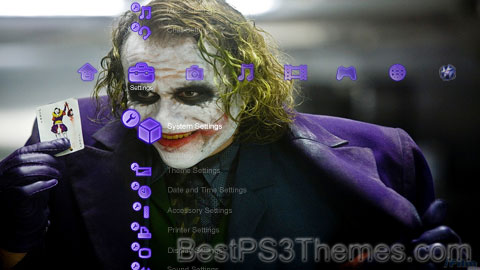
(3 backgrounds)
Redirect to:
This page is a redirect. The following categories are used to track and monitor this redirect:
|

The #1 spot for Playstation themes!
The Joker theme by PDSangster
Download: Joker_2.p3t

(3 backgrounds)
Redirect to:
This page is a redirect. The following categories are used to track and monitor this redirect:
|
Hulk Vs. Wolverine 2.0 theme by ZHero
Download: HulkVsWolverine2.p3t
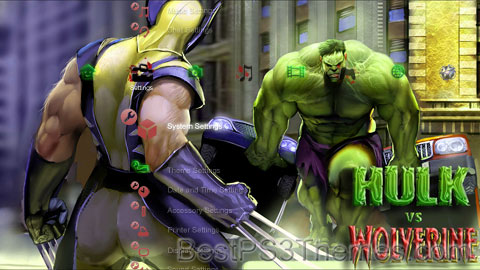
(9 backgrounds)
P3T Unpacker v0.12
Copyright (c) 2007. Anoop Menon
This program unpacks Playstation 3 Theme files (.p3t) so that you can touch-up an existing theme to your likings or use a certain wallpaper from it (as many themes have multiple). But remember, if you use content from another theme and release it, be sure to give credit!
Download for Windows: p3textractor.zip
Instructions:
Download p3textractor.zip from above. Extract the files to a folder with a program such as WinZip or WinRAR. Now there are multiple ways to extract the theme.
The first way is to simply open the p3t file with p3textractor.exe. If you don’t know how to do this, right click the p3t file and select Open With. Alternatively, open the p3t file and it will ask you to select a program to open with. Click Browse and find p3textractor.exe from where you previously extracted it to. It will open CMD and extract the theme to extracted.[filename]. After that, all you need to do for any future p3t files is open them and it will extract.
The second way is very simple. Just drag the p3t file to p3textractor.exe. It will open CMD and extract the theme to extracted.[filename].
For the third way, first put the p3t file you want to extract into the same folder as p3textractor.exe. Open CMD and browse to the folder with p3extractor.exe. Enter the following:
p3textractor filename.p3t [destination path]Replace filename with the name of the p3t file, and replace [destination path] with the name of the folder you want the files to be extracted to. A destination path is not required. By default it will extract to extracted.filename.
Ironman Mark 3 theme by myownscars
Download: IronmanMark3.p3t
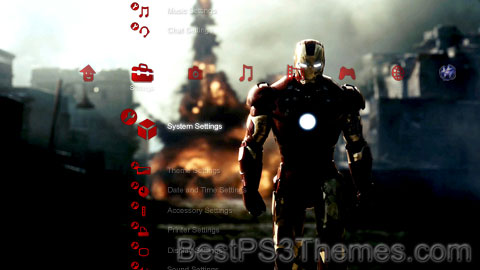
(8 backgrounds)
P3T Unpacker v0.12
Copyright (c) 2007. Anoop Menon
This program unpacks Playstation 3 Theme files (.p3t) so that you can touch-up an existing theme to your likings or use a certain wallpaper from it (as many themes have multiple). But remember, if you use content from another theme and release it, be sure to give credit!
Download for Windows: p3textractor.zip
Instructions:
Download p3textractor.zip from above. Extract the files to a folder with a program such as WinZip or WinRAR. Now there are multiple ways to extract the theme.
The first way is to simply open the p3t file with p3textractor.exe. If you don’t know how to do this, right click the p3t file and select Open With. Alternatively, open the p3t file and it will ask you to select a program to open with. Click Browse and find p3textractor.exe from where you previously extracted it to. It will open CMD and extract the theme to extracted.[filename]. After that, all you need to do for any future p3t files is open them and it will extract.
The second way is very simple. Just drag the p3t file to p3textractor.exe. It will open CMD and extract the theme to extracted.[filename].
For the third way, first put the p3t file you want to extract into the same folder as p3textractor.exe. Open CMD and browse to the folder with p3extractor.exe. Enter the following:
p3textractor filename.p3t [destination path]Replace filename with the name of the p3t file, and replace [destination path] with the name of the folder you want the files to be extracted to. A destination path is not required. By default it will extract to extracted.filename.
Ironman Mark 2 theme by myownscars
Download: IronmanMark2.p3t
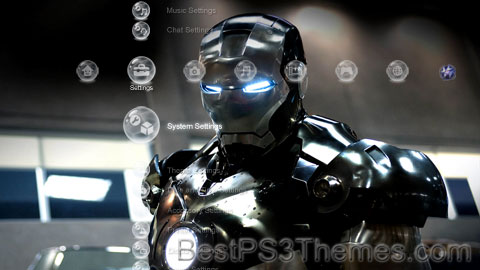
(2 backgrounds)
P3T Unpacker v0.12
Copyright (c) 2007. Anoop Menon
This program unpacks Playstation 3 Theme files (.p3t) so that you can touch-up an existing theme to your likings or use a certain wallpaper from it (as many themes have multiple). But remember, if you use content from another theme and release it, be sure to give credit!
Download for Windows: p3textractor.zip
Instructions:
Download p3textractor.zip from above. Extract the files to a folder with a program such as WinZip or WinRAR. Now there are multiple ways to extract the theme.
The first way is to simply open the p3t file with p3textractor.exe. If you don’t know how to do this, right click the p3t file and select Open With. Alternatively, open the p3t file and it will ask you to select a program to open with. Click Browse and find p3textractor.exe from where you previously extracted it to. It will open CMD and extract the theme to extracted.[filename]. After that, all you need to do for any future p3t files is open them and it will extract.
The second way is very simple. Just drag the p3t file to p3textractor.exe. It will open CMD and extract the theme to extracted.[filename].
For the third way, first put the p3t file you want to extract into the same folder as p3textractor.exe. Open CMD and browse to the folder with p3extractor.exe. Enter the following:
p3textractor filename.p3t [destination path]Replace filename with the name of the p3t file, and replace [destination path] with the name of the folder you want the files to be extracted to. A destination path is not required. By default it will extract to extracted.filename.
Ironman theme by myownscars
Download: Ironman_4.p3t
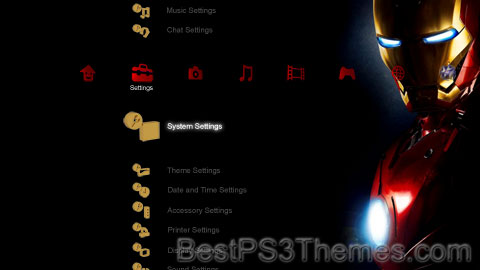
(8 backgrounds)
Iron Man, Ironman or Ironmen may refer to:
Ghost Rider theme by myownscars
Download: GhostRider_3.p3t
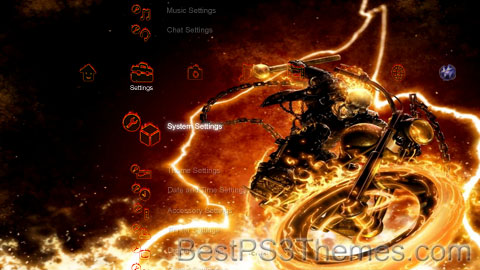
(5 backgrounds)
| Ghost Rider | |
|---|---|
 Ghost Rider on the cover of Marvel Spotlight #5 (Aug. 1972). | |
| Publication information | |
| Publisher | Marvel Comics |
| First appearance | Marvel Spotlight #5 (August 1972) |
| Created by | |
| In-story information | |
| Alter ego |
|
| Species | Human/demon hybrid |
| Team affiliations |
|
| Notable aliases |
|
| Abilities |
|
Ghost Rider is the name of multiple superheroes or antiheroes appearing in American comic books published by Marvel Comics. Marvel had previously used the name for a Western character whose name was later changed to Phantom Rider.
The first supernatural Ghost Rider is stunt motorcyclist Johnny Blaze, who sold his soul, to save the life of his foster father, agrees to give his soul to "Satan" (later revealed to be an arch-demon named Mephisto). At night and when around evil, Blaze finds his flesh consumed by hellfire, causing his head to become a flaming skull. He rides a fiery motorcycle and wields blasts of hellfire from his body, usually from his skeletal hands. He eventually learns he has been bonded with the demon Zarathos. Blaze is featured in the series Ghost Rider (vol. 2) from 1972 to 1983.
The subsequent Ghost Rider series (1990–1998) features Danny Ketch as a new Ghost Rider. After his sister was injured by ninja gangsters, Ketch comes in contact with a motorcycle that contains the essence of a Spirit of Vengeance. Blaze reappears in this 1990s series as a supporting character, and it is later revealed that Danny and his sister were Johnny Blaze's long-lost siblings. In 2000s comics, Blaze succeeds Ketch, becoming Ghost Rider again. In 2014, Robbie Reyes becomes Ghost Rider as part of the Marvel NOW! initiative.
In May 2011, Ghost Rider placed 90th on IGN's "Top 100 Comic Book Heroes" list.[1] Nicolas Cage starred as the Johnny Blaze incarnation of the character in the 2007 film Ghost Rider and its 2012 sequel, Ghost Rider: Spirit of Vengeance. Gabriel Luna and Tom McComas portray the Robbie Reyes and Johnny Blaze incarnations in the fourth season of the Marvel Cinematic Universe (MCU) television series Agents of S.H.I.E.L.D., with Henry Simmons and Clark Gregg portraying original incarnations Alphonso Mackenzie and Phil Coulson.
Following the Western comics character who originally used the name, the first superhero Ghost Rider, Johnny Blaze, debuted in Marvel Spotlight issue #5 (Aug. 1972), created by Marvel editor-in-chief Roy Thomas,[2] writer Gary Friedrich and artist Mike Ploog. He received his own series in 1973, with penciller Jim Mooney handling most of the first nine issues. Several different creative teams mixed-and-matched until penciller Don Perlin began a considerably long stint with issue #26, eventually joined by writer Michael Fleisher through issue #58. The series ran through issue #81 (June 1983). Blaze returned as Ghost Rider in a 2001 six-issue miniseries written by Devin Grayson; a second miniseries written by Garth Ennis in 2005, and an ongoing monthly series that began publication in July 2006. Johnny Blaze was the son of Naomi Blaze and Barton Blaze. Naomi was the previous Ghost Rider.
The next Ghost Rider, a young man named Daniel "Danny" Ketch (Johnny Blaze's long-lost younger brother), debuted in Ghost Rider (vol. 3) #1 (May 1990). This Ghost Rider was nearly identical to the previous, although his costume was now a black leather biker jacket with spiked shoulder-pads, grey leather pants, and a mystic chain he wore across his chest, which responded to his mental commands and served as his primary melee weapon. His new motorcycle resembled a futuristic machine and the front of it could lower to serve as a battering ram. Like the original Ghost Rider's bike, the wheels were composed of mystic hellfire. Unlike the relationship between the previous Ghost Rider and the demon with which he was bonded, Ketch and his demon — who in (vol. 3) #91 (Dec. 1997) is revealed to be Marvel's incarnation of the Angel of Death/Judgment — are cooperative with each other. At the close of the series with (vol. 3) #93 (Feb. 1998), Ketch apparently died. The following year, however, Peter Parker: Spider-Man #93 (July 1999) revealed Ketch was still alive. Nearly a decade later, Marvel published the long-completed final issue as Ghost Rider Finale (Jan. 2007), which reprints the last issue and the previously unpublished Ghost Rider (vol. 3) #94.[3]
During the 2011 storyline "Fear Itself", a Nicaraguan woman named Alejandra Jones becomes Ghost Rider through a ritual performed by a man named Adam. Though she demonstrates many previously unknown powers of the Ghost Rider entity, she is deprived of its full power when Johnny Blaze takes back most of this power in (Vol. 7) #9. She was killed by Carnage during the Absolute Carnage event.
In 2014, a new character took on the Ghost Rider mantle: a Mexican-American resident of East Los Angeles named Roberto "Robbie" Reyes, who drives a black classic muscle car reminiscent of a modified 1969 Dodge Charger rather than a motorcycle.[4][5] Robbie Reyes was created by writer/artist Felipe Smith and designed by Smith and artist Tradd Moore.[6]
Michael Badilino, an ex-member of the New York City Police Department, is one-third of an "Organic Medallion of Power"; the other two are Ketch and Blaze (the Medallion itself was never explained in any true detail). He possesses powers more in line with those of the Zarathos version of Ghost Rider, although he also possesses the Penance Stare and his motorcycle seemed to share characteristics with the Noble Kale version. His appearance is distinguished by a deep purple skull, large fangs protruding from his upper jaw, and backswept curved horns on the top of his skull.
In his superhuman form, Badilino was called Vengeance, and originally attempted to kill the Ghost Rider, believing him to be Zarathos. Vengeance later became the ally of Ghost Rider and Johnny Blaze. Vengeance also took on the role of the Ghost Rider and even semi-seriously referred to himself by that name when confronted by Spider-Man shortly after the apparent death of Ghost Rider in battle with Zarathos and acolytes The Fallen. Vengeance killed himself, along with the villain Hellgate, by triggering a massive explosion through his Hellfire, the source of the mystical flames that encompass the bones of both Vengeance and Ghost Rider.
Vengeance reappears in the last four issues of Ghost Rider (vol. 3), involved in Blackheart's plans to kill Noble Kale. Vengeance aids the Ghost Rider in the ensuing battle, destroying Blackheart and ruling Hell during Ketch's absences.
In the 19th century, while her tribe was being attacked by the U.S. Army, Kushala's parents were killed and, in an act of rage, she prayed to her creator, but instead was possessed by a Spirit of Vengeance. Then she burnt everyone until all that remained were their spirits. After becoming possessed by the Spirit of Vengeance, Kushala traveled the world seeking out and studying different forms of magic in an attempt to cure herself. Her skills in the mystic arts eventually led to her becoming the Sorcerer Supreme of her era.
The Ghost Rider is a human who can transform into a skeletal superhuman wreathed in ethereal flame and given supernatural powers. The abnormal motorcycle he rides can travel faster than any conventional vehicle and perform impossible feats such as riding up a vertical surface, across water, and leaping across great distances that normal motorcycles cannot. The Ghost Riders are virtually indestructible and notoriously hard to injure by any conventional means, as bullets and knives usually pass through them without causing pain (knives are shown to melt while in their body).[7] It is possible that they are genuinely immortal, as it is said that God created them and only God can destroy them.[8] Despite being composed of bone and hellfire, the Ghost Riders possess formidable superhuman strength, enough to easily pick up a truck and hurl it across a road. It has been stated that Johnny Blaze as Ghost Rider can bench press around 25 tons (50,000 lbs) (or more as seen in World War Hulk).[9] Each Ghost Rider entity also had abilities specific to him or her.
Naomi Kale is the mother of Johnny Blaze, Danny Ketch, and Barbara Ketch.
Noble lived in the 18th century and grew up with his abusive father Pastor Kale and his younger brother Dante.
Noble fell in love with a black girl named Magdelena. But, because of the color of her skin and his father's strong religious views, the couple kept their love a secret from the world. They were forced to tell Pastor Kale when Magdelena bore Noble's child. Noble and Magdelena were then married.
Shortly after the marriage, Magdelena discovered Pastor Kale's dark secret; he was a servant of the dark lord Mephisto. To cover up Magdelena's findings, Pastor Kale accused her of witchcraft and had her burned at the stake. Knowing that his son, Noble, would object, he had him drugged, tortured and beaten in the church cellar.
Just before Magdelena died, she used a curse to summon demons that avenge wronged women. The demons were called "Furies" and they started killing the townspeople. Fearing death, Pastor Kale struck a deal with Mephisto. In return for his safety, Mephisto got Noble's soul. Mephisto realized that Noble was attached to a piece of the Medallion of Power and he activated the piece to transform Noble into the original "Spirit of Vengeance". When Ghost Rider had destroyed the Furies, Pastor offered him human flesh - Noble's son. Noble, in the guise of Ghost Rider, was unwilling to eat his own child and he killed himself.
When Mephisto later appeared to claim Noble's soul, Mephisto's brother, the archangel Uriel, appeared and demanded that the soul of Noble Kale be spared. No agreement could be reached, and therefore a compromise was made whereby Noble's soul could not be claimed by either realm; but instead, his soul would remain in the void until re-bonded with certain members of his family.[13]
Noble Kale was also established as an ancestor of Jennifer Kale.[14]
Due to the Celestial Progenitor presence influencing human evolution, in 1,000,000 B.C., certain humans became much more intelligent than others as well as able to speak a new language. However, they had to hide that gift from their brethren for fear of being ostracized. One day, a boy that was gifted with the ability to speak is approached by a mysterious stranger that also possessed that gift, only to witness the stranger transform into a beast and devour his entire tribe. The stranger allowed the boy to live and names him "Ghost" before telling him to challenge him when he is worthy. The boy was forced to survive on his own, though he does befriend a woolly mammoth. After almost dying in the harsh environment, he is approached by Mephisto in the form of a snake, who tells him to say its name. Ghost does that and is bonded with a Spirit of Vengeance; after which he imbued his newly acquired hellfire into the mammoth. Other humans had never seen someone ride an animal before and began referring to Ghost as "the Rider". The Rider continued his search and five years later, eventually caught up with the man who devoured his tribe. The man transformed once more, revealing himself to be the first Wendigo. During the fight, the Rider took the bones of the dead that the Wendigo had killed and used them to form a weapon; the earliest version of the Ghost Rider's signature chain. The Rider fought the Wendigo until finally it and the Rider's woolly mammoth tumbled over a cliff. Afterwards, Ghost was approached by Odin and Lady Phoenix to join the prehistoric version of the Avengers.[15]
Upon imbuing his hellfire into another woolly mammoth, the Ghost Rider assisted the prehistoric Avengers (consisting of Agamotto, Odin, Lady Phoenix, and prehistoric versions of the Black Panther, Iron Fist, and Star Brand) in fighting an out of control Celestial called the Fallen; which resulted in his woolly mammoth getting killed in action. The Ghost Rider swore revenge and assisted his teammates in defeating the Fallen and sealing it away underground in what would become South Africa.[11] The Ghost Rider later assisted the prehistoric Avengers in fighting the First Host.[16]
During the 11th century, a Native American chieftain from the Sioux nation named Hellhawk sported the powers of the Ghost Rider. He was part of Thor's Avengers of 1,000 A.D.[17][18]
During the 17th century, Hellhawk developed a rivalry with Noble Kane.[19] He was later killed by Narcosis to serve as a warning to Mephisto by Belasco to keep his Spirits of Vengeance out of Limbo.[20]
Seven riders show their flaming heads for the first time in this story arc by writer Jason Aaron and artist Tan Eng Huat. Daniel Ketch returns with a new mission: to collect the powers of all the Ghost Riders for the angel Zadkiel to prevent the corruption of the powers with their human hosts. Zadkiel has other motives he keeps to himself, for which he needs the powers of the riders to tear down the walls of New Jerusalem and wage war on the heavens.
A version of Ghost Rider appeared in the miniseries Ghost Rider: Trail of Tears #1–6 (April–Sept. 2007) by writer Garth Ennis and artist Clayton Crain. Set during the American Civil War, it finds Confederate officer Travis Parham avenging the murders of his friend, an ex-slave named Caleb and Caleb's family. Parham meets a horse-riding Ghost Rider who seeks the same men. Eventually, Parham learns about the deaths instrumental in helping set forth the Spirit of Vengeance.
During the 19th century, an unnamed Ghost Rider was active during the American frontier. He targeted anyone who killed Native American women and children or who cut off their scalps.[19]
Deputy Kowalski was a normal cop in a small town until Ghost Rider rode in one day. It was then that Kowalski was kidnapped by a local cannibal who cut off his hand. Events transpired that led to Kowalski escaping and developing a wrath against the Ghost Rider. His attention was brought to the hellfire shotgun in possession of Badilino. After purchasing the gun—and discovering to Badilino's surprise that it will work for Kowalski—Kowalski was recruited by agents of Zadkiel and told to wait in the middle of the desert for the Ghost Rider. Johnny Blaze (as Ghost Rider) did arrive in hot pursuit of Danny Ketch (as a new incarnation of Ghost Rider). Kowalski did manage to get a shot in on Blaze. Although it was a minor setback Blaze resumed his pursuit of Ketch. Left in the desert Kowalski soon found himself transformed into the new Vengeance, sporting green flames and a hook for his right hand, after Ketch returned the powers of the Spirits of Vengeance to Earth.[volume & issue needed]
With a thirst for revenge, Kowalski, as Vengeance, was recruited by Blackout as a member of Zadkiel's Ghost Rider Assassination League.[21] Kowalski was partnered with The Orb and was to stop Blaze and Ketch from reaching a monastery which contained a gateway to Heaven. Kowalski was easily defeated by both Ghost Riders and was left as a pet with the monastery's Mother Superior.[22]
Vengeance was later freed by the Shadow Council and joins the ninth incarnation of the Masters of Evil.[23]
Indiana Jones version 2 theme by Windrider
Download: IndianaJonesV2.p3t
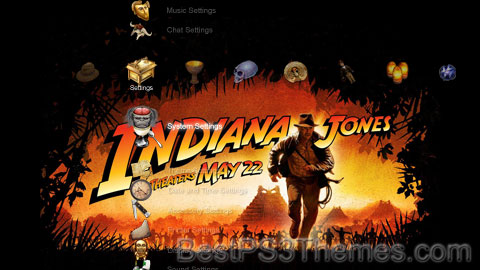
(4 backgrounds)
P3T Unpacker v0.12
Copyright (c) 2007. Anoop Menon
This program unpacks Playstation 3 Theme files (.p3t) so that you can touch-up an existing theme to your likings or use a certain wallpaper from it (as many themes have multiple). But remember, if you use content from another theme and release it, be sure to give credit!
Download for Windows: p3textractor.zip
Instructions:
Download p3textractor.zip from above. Extract the files to a folder with a program such as WinZip or WinRAR. Now there are multiple ways to extract the theme.
The first way is to simply open the p3t file with p3textractor.exe. If you don’t know how to do this, right click the p3t file and select Open With. Alternatively, open the p3t file and it will ask you to select a program to open with. Click Browse and find p3textractor.exe from where you previously extracted it to. It will open CMD and extract the theme to extracted.[filename]. After that, all you need to do for any future p3t files is open them and it will extract.
The second way is very simple. Just drag the p3t file to p3textractor.exe. It will open CMD and extract the theme to extracted.[filename].
For the third way, first put the p3t file you want to extract into the same folder as p3textractor.exe. Open CMD and browse to the folder with p3extractor.exe. Enter the following:
p3textractor filename.p3t [destination path]Replace filename with the name of the p3t file, and replace [destination path] with the name of the folder you want the files to be extracted to. A destination path is not required. By default it will extract to extracted.filename.
The Dark Knight 3.0 theme by Daytripper
Download: DarkKnight3.p3t
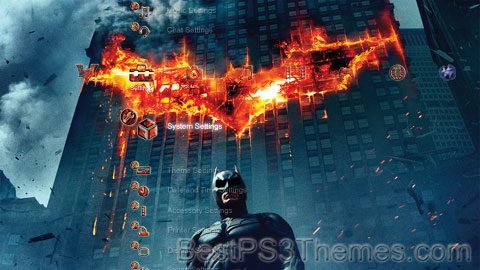
(1 background)
P3T Unpacker v0.12
Copyright (c) 2007. Anoop Menon
This program unpacks Playstation 3 Theme files (.p3t) so that you can touch-up an existing theme to your likings or use a certain wallpaper from it (as many themes have multiple). But remember, if you use content from another theme and release it, be sure to give credit!
Download for Windows: p3textractor.zip
Instructions:
Download p3textractor.zip from above. Extract the files to a folder with a program such as WinZip or WinRAR. Now there are multiple ways to extract the theme.
The first way is to simply open the p3t file with p3textractor.exe. If you don’t know how to do this, right click the p3t file and select Open With. Alternatively, open the p3t file and it will ask you to select a program to open with. Click Browse and find p3textractor.exe from where you previously extracted it to. It will open CMD and extract the theme to extracted.[filename]. After that, all you need to do for any future p3t files is open them and it will extract.
The second way is very simple. Just drag the p3t file to p3textractor.exe. It will open CMD and extract the theme to extracted.[filename].
For the third way, first put the p3t file you want to extract into the same folder as p3textractor.exe. Open CMD and browse to the folder with p3extractor.exe. Enter the following:
p3textractor filename.p3t [destination path]Replace filename with the name of the p3t file, and replace [destination path] with the name of the folder you want the files to be extracted to. A destination path is not required. By default it will extract to extracted.filename.
Resident Evil theme by Megatron
Download: ResidentEvil_9.p3t
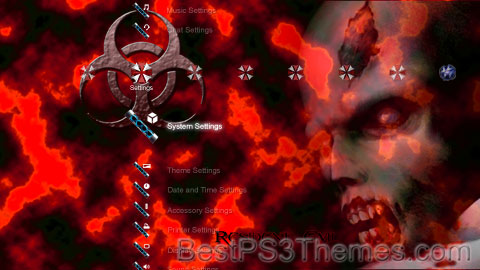
(1 background)
| Resident Evil | |
|---|---|
 | |
| Created by | Shinji Mikami Tokuro Fujiwara |
| Original work | Resident Evil (1996) |
| Owner | Capcom |
| Years | 1996–present |
| Print publications | |
| Novel(s) | Novel list |
| Comics | Comic list |
| Films and television | |
| Film(s) | |
| Television series | Television list |
| Games | |
| Video game(s) | Video game list |
| Official website | |
| game | |
Resident Evil is a Japanese horror game series and media franchise created by Capcom. It consists of survival horror, third-person shooter and first-person shooter games, with players typically surviving in post-apocalyptic urban environments infested with mutant humanoids and bizarre animals (such as mutated dogs), zombies and other lethal creatures. The franchise has expanded into other media, most notably a live-action film series, as well as animated films, television series, comic books, novels, audiobooks, and merchandise including clothing, costumes, action figures and toys. Resident Evil is the highest-grossing horror franchise.
The first Resident Evil game was created by Shinji Mikami and Tokuro Fujiwara for PlayStation, and released in 1996.[1][2] It is credited for defining the survival horror genre and returning zombies to popular culture. By the time of Resident Evil 4 (2005), the franchise shifted to more dynamic shooting action, achieved critical acclaim, and influenced the evolution of the survival horror and third-person genres, popularizing the "over-the-shoulder" third-person view.[3]
The franchise returned to survival horror with Resident Evil 7: Biohazard (2017) and Resident Evil Village (2021), which used a first-person perspective. Capcom has also released four Resident Evil remakes: Resident Evil (2002), Resident Evil 2 (2019), Resident Evil 3 (2020) and Resident Evil 4 (2023). Resident Evil is Capcom's best-selling franchise and the best-selling horror game series, with 154 million copies sold worldwide, as of December 2023.[4]
The first Resident Evil action film was released in 2002, starring Milla Jovovich, followed by five further sequels and a reboot, Welcome to Raccoon City (2021). The films have received mostly negative critical reviews, including on Rotten Tomatoes and some on Metacritic; however, some of the films have received mixed reviews on Metacritic. Nevertheless, the films have grossed more than $1.2 billion, making Resident Evil the third-highest-grossing video game film series.
The development of the first Resident Evil, released as Biohazard in Japan, began in 1993 when Capcom's Tokuro Fujiwara told Shinji Mikami and other co-workers to create a game using elements from Fujiwara's 1989 game Sweet Home on the Family Computer (Famicom) in Japan.[5][6] When in late 1994 marketing executives were setting up to release Biohazard in the United States, it was pointed out that securing the rights to the name Biohazard would be very difficult as a DOS game had been registered under that name, as well as a New York hardcore punk band called Biohazard. A contest was held among company personnel to choose a new name; this competition turned up Resident Evil, the name under which it was released in the west.[7] Resident Evil made its debut on the PlayStation in 1996 and was later ported to the Sega Saturn.
The first entry in the series was the first game to be dubbed a "survival horror", a term coined for the new genre it initiated,[8] and its critical and commercial success[9] led to the production of two sequels, Resident Evil 2 in 1998 and Resident Evil 3: Nemesis in 1999, both for the PlayStation. A port of Resident Evil 2 was released for the Nintendo 64. In addition, ports of all three were released for Windows. The fourth game in the series, Resident Evil – Code: Veronica, was developed for the Dreamcast and released in 2000, followed by ports of Resident Evil 2 and Resident Evil 3: Nemesis. Resident Evil – Code: Veronica was later re-released for Dreamcast in Japan in an updated form as Code: Veronica Complete, which included slight changes, many of which revolved around story cutscenes. This updated version was later ported to the PlayStation 2 and GameCube under the title Code: Veronica X.
Despite earlier announcements that the next game in the series would be released for the PlayStation 2, which resulted in the creation of an unrelated game titled Devil May Cry, series' creator and producer Shinji Mikami decided to make the series exclusively for the GameCube.[10] The next three games in the series—a remake of the original Resident Evil and the prequel Resident Evil Zero, both released in 2002, as well as Resident Evil 4 (2005)—were all released initially as GameCube exclusives. Resident Evil 4 was later released for Windows, PlayStation 2, and Wii.
A trilogy of GunCon-compatible light gun games known as the Gun Survivor series featured first-person gameplay. The first, Resident Evil Survivor, was released in 2000 for the PlayStation and PC but received mediocre reviews.[11] The subsequent games, Resident Evil Survivor 2 – Code: Veronica and Resident Evil: Dead Aim, fared somewhat better.[12] Dead Aim is the fourth Gun Survivor game in Japan, with Gun Survivor 3 being the Dino Crisis spin-off Dino Stalker. In a similar vein, the Chronicles series features first-person gameplay, albeit on an on-rails path. Resident Evil: The Umbrella Chronicles was released in 2007 for the Wii, with a sequel, Resident Evil: The Darkside Chronicles released in 2009 (both were later ported to the PlayStation 3 in 2012).[13]
Resident Evil Outbreak is an online game for the PlayStation 2, released in 2003, depicting a series of episodic storylines in Raccoon City set during the same period as Resident Evil 2 and Resident Evil 3: Nemesis. It was the first in the series and the first survival horror title to feature cooperative gameplay.[14] It was followed by a sequel, Resident Evil Outbreak: File #2. Raccoon City is a metropolis located in the Arklay Mountains of the Midwestern United States that succumbed to the deadly T-virus outbreak and was consequently destroyed via a nuclear missile attack issued by the United States government. The town served as a critical junction for the series' progression as one of the main catalysts to Umbrella's downfall and the entry point for some of the series' most notable characters.
Resident Evil Gaiden is an action-adventure game for the Game Boy Color featuring a role-playing-style combat system. There have been several downloadable mobile games based on the Resident Evil series in Japan. Some of these mobile games have been released in North America and Europe through T-Mobile. At the Sony press conference during E3 2009, Resident Evil Portable was announced for the PlayStation Portable,[15][16][17] described as an all-new title being developed with "the PSP Go in mind" and "totally different for a Resident Evil game". No further announcements have been made, and the game is considered to have been canceled.[18][19]
In 2009, Resident Evil 5 was released for PlayStation 3, Windows and Xbox 360, becoming the best selling game of the franchise despite mixed fan reception. Capcom revealed the third-person shooter Resident Evil: Operation Raccoon City, which was developed by Slant Six Games for the PlayStation 3, Xbox 360 and Windows and released in March 2012. A survival horror game for the Nintendo 3DS, Resident Evil: Revelations, was released in February 2012.[20] In October of the same year, the next numbered entry in the main series, Resident Evil 6, was released to mixed reviews,[21] but enthusiastic pre-order sales.[22]
In 2013, producer Masachika Kawata said the Resident Evil franchise would return to focus on elements of horror and suspense over action, adding that "survival horror as a genre is never going to be on the same level, financially, as shooters and much more popular, mainstream games. At the same time, I think we need to have the confidence to put money behind these projects, and it doesn't mean we can't focus on what we need to do as a survival horror game to meet fan's needs."[23] Resident Evil: Revelations 2, an episodic game set between Resident Evil 5 and Resident Evil 6, was released in March 2015. A series of team-based multiplayer games were developed beginning with the poorly received Umbrella Corps, which was released in June 2016.[24] Resident Evil: Resistance was released in April 2020, followed by Resident Evil Re:Verse in October 2022, with both being available for free to those who bought Resident Evil 3 and Village respectively.[25][26]
Using the new RE Engine, which would develop the next generation of Resident Evil games, the series continued to shift back towards more horror elements. The next mainline game, Resident Evil 7: Biohazard was released for Windows, PlayStation 4 and Xbox One in January 2017.[27][28] Set in a dilapidated mansion in Louisiana, the game uses a first-person perspective and emphasizes horror and exploration over action, unlike previous installments.[29][30][31][32] The first-person perspective continued in the eighth mainline game Resident Evil Village. Released in May 2021, the game, set in a mysterious European village, is a direct sequel to Resident Evil 7: Biohazard although it incorporates more action elements inspired from Resident Evil 4.[33][34] The game also marked the franchise's debut on PlayStation 5 and Xbox Series X/S[35]
A new generation of remakes of older entries began in 2019 with a remake of Resident Evil 2, being released for the PlayStation 4, Windows, and Xbox One. The remake outsold the original game within a year, selling over five million copies.[36] Following in the success of the Resident Evil 2 remake, Capcom revealed a remake of Resident Evil 3: Nemesis in December 2019, known as Resident Evil 3. It was released in April 2020.[37] In June 2022, a remake of Resident Evil 4 was announced and released on March 24, 2023 for PlayStation 4, PlayStation 5, Xbox Series X/S, and PC.[38]
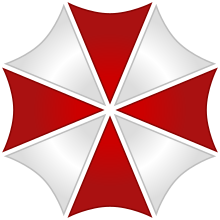
The early Resident Evil games focused on the Umbrella Corporation, an international pharmaceutical company that secretly develops mutagenic viruses to further their "bio-organic weapons" (BOW) research. The company's viruses can transform humans into mindless zombies while also mutating plants and animals into horrifying monstrosities. The Umbrella Corporation uses its vast resources to effectively control Raccoon City, a fictional midwestern American city. In the original Resident Evil, members of an elite police task force, Special Tactics and Rescue Service (STARS), are lured to a derelict mansion on the outskirts of Raccoon City. The STARS team is mostly decimated by zombies and other BOWs, leaving only a handful of survivors, including Chris Redfield, Jill Valentine, and Albert Wesker. Chris and Jill explore the zombie-infested mansion and uncover a secret underground Umbrella research facility. Wesker reveals himself to be a double agent for Umbrella and betrays his comrades. However, Wesker is seemingly murdered by a Tyrant, a special BOW that is the culmination of the Umbrella Corporation's research.[39][40]
Chris and Jill escape the mansion, but their testimony is ridiculed by Raccoon City's officials due to Umbrella's influence. Meanwhile, a separate viral outbreak occurs in another Umbrella research facility underneath Raccoon City. Most of the city's residents are infected and become zombies. Resident Evil 2 introduces two new protagonists, Leon S. Kennedy, a rookie police officer and Claire Redfield, the younger sister of Chris. Leon and Claire arrive in Raccoon City amidst the chaos of the viral outbreak. Leon is aided by Ada Wong, a corporate spy posing as an FBI agent, while Claire rescues Sherry Birkin, the daughter of two prominent Umbrella researchers. At the same time, Jill makes her escape from the city in Resident Evil 3: Nemesis. She is relentlessly pursued by a new Tyrant, Nemesis, who is deployed by Umbrella to eliminate all surviving STARS members. The U.S. Government destroys Raccoon City with a missile strike to sterilize the viral outbreak.[41] Leon, Claire, Sherry, Ada, and Jill escape the city before its eradication. Claire continues to look for Chris, whereas Leon is recruited to work for the U.S. Government. Resident Evil – Code: Veronica follows Claire as she escapes from a prison camp in the Southern Ocean and later reunites with Chris at an Umbrella research facility in Antarctica. Resident Evil 4 is set six years after the Raccoon City incident and focuses on Leon as he tries to rescue the U.S. President's daughter from a cult in Spain.[39][40]
A government investigation into the Umbrella Corporation reveals its involvement in the Raccoon City disaster and leads to the company's dissolution. Despite the downfall of the Umbrella Corporation, the company's research and BOWs proliferate across the black market and lead to the rise of bioterrorism. Chris and Jill establish the Bioterrorism Security Assessment Alliance (BSAA) to combat these ever-growing threats on a global scale. Wesker is revealed to be alive and involved in the development of new potent viral agents and BOWs. In Resident Evil 5, Wesker seeks to unleash a highly mutagenic virus that will infect all of humanity. Chris and the BSAA confront and kill Wesker in Africa before he can fulfill his mission.[42] Resident Evil 6 features Leon and Chris meeting for the first time in the video game series.[43] The two work separately to triage bioterrorist attacks in the United States, Eastern Europe, and China. They are assisted by Sherry, Wesker's illegitimate son Jake Muller, Ada, and many members of the BSAA and U.S. government.
Resident Evil 7: Biohazard and Resident Evil Village introduce a new protagonist, Ethan Winters, who becomes entangled in a bioterrorism incident while searching for his missing wife. He encounters Chris and the BSAA, who help him rescue his wife and defeat Eveline, a powerful BOW. Ethan, Mia, and their newborn daughter, Rosemary, are relocated to Eastern Europe but are abducted by a cult. Ethan ultimately sacrifices himself to destroy a fungal colony being weaponized by bioterrorists and save his family.[39][40][44]
The Resident Evil franchise has had a variety of control schemes and gameplay mechanics throughout its history. Puzzle-solving has figured prominently throughout the series.[45]
The first game introduced a control scheme that the player community has come to refer to as "tank controls" to the series. In a game with tank controls, players control movement relative to the position of the player character, rather than relative to the fixed virtual camera from which the player views the current scene.[46] Pressing up (for example on a D-pad, analog stick, or cursor movement keys) on the game controller moves the character in the direction being faced, pressing down backpedals, and left and right rotates the character.[46] This can feel counter-intuitive when the character is facing the camera, as the controls are essentially reversed in this state. This differs from many 3D games, in which characters move in the direction the player pushes the controls from the perspective of the camera.[46] Some critics have posited that the control scheme is intentionally clumsy, meant to enhance stress and exacerbate difficulty.[47]
While the first three entries in the series featured this control scheme, the third, Resident Evil 3: Nemesis, saw some action-oriented additions. These included a 180 degree turn and dodge command that, according to GameSpot, "hinted at a new direction that the series would go in." Later games in the series, like Resident Evil 4, would feature a more fluid over-the-shoulder third-person camera instead of a fixed camera for each room, while Resident Evil 7 and Resident Evil Village are played from the first-person perspective.
Resident Evil 4 saw significant changes to the established gameplay, including switching from fixed camera perspectives to a tracking camera, and more action-oriented gameplay and mechanics. This was complemented by an abundance of ammunition and revised aiming and melee mechanics. Some critics claimed that this overhauled control scheme "made the game less scary."[47] The next two games in the franchise furthered the action-oriented mechanics: Resident Evil 5 featured cooperative play and added strafing, while Resident Evil 6 allowed players to move while aiming and shooting for the first time, fully abandoning the series' signature tank controls.[47]
Resident Evil 7 is the first main Resident Evil game to use the first-person perspective and to use virtual reality. It drew comparisons to modern survival horror games such as Outlast and PT.[47] The eighth main-series game, Resident Evil Village, also features a first-person perspective.[48] A VR version of Resident Evil 4 was released on the Oculus Quest 2 on October 21, 2021.[49]
The Resident Evil franchise features video games and tie-in merchandise and products, including various live-action and animated films, comic books, and novels.

From 2002 to 2016, six live-action Resident Evil films were produced, all written and produced by Paul W. S. Anderson. The films do not follow the games' premise but feature some game characters. The series' protagonist is Alice, an original character created for the films portrayed by Milla Jovovich. Despite a negative reaction from critics, the live-action film series has made over $1 billion worldwide.[50] They are, to date, the only video game adaptations to increase the amount of money made with each successive film.[51] The series holds the record for the "Most Live-Action Film Adaptations of a Video Game" in the 2012 Guinness World Records Gamer's Edition, which also described it as "the most successful movie series to be based on a video game."[14]
A reboot, Resident Evil: Welcome to Raccoon City, was released on November 24, 2021, with Johannes Roberts as writer/director.[52]
The first computer animated film for the franchise was Biohazard 4D-Executer. It was a short 3D film produced for Japanese theme parks and did not feature any characters from the game.[53]
Starting in 2008, a series of feature-length computer-animated films have been released. These films take place in the same continuity with the games of the series, and feature characters such as Leon Kennedy, Claire Redfield, Ada Wong, Chris Redfield,
Spider-man theme by myownscars Download: Spider-man.p3t Redirect to:Spider-man
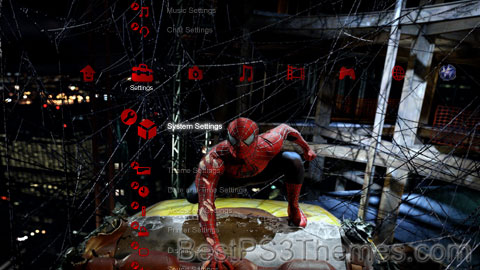
(7 backgrounds)